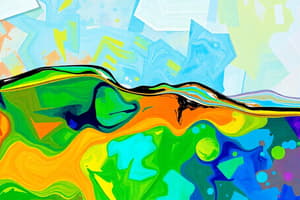Podcast
Questions and Answers
The basic units of matter, the smallest units that maintain the chemical properties of an element, are called
The basic units of matter, the smallest units that maintain the chemical properties of an element, are called
Which layer of Earth is made of solid metal?
Which layer of Earth is made of solid metal?
The law of conservation matter states that ________.
The law of conservation matter states that ________.
Because of their large size, proteins, nucleic acids, carbohydrates, and lipids are together called
Because of their large size, proteins, nucleic acids, carbohydrates, and lipids are together called
Signup and view all the answers
Which type of plate boundary is where the plates collide?
Which type of plate boundary is where the plates collide?
Signup and view all the answers
Enzymes are an example of a _________________________
Enzymes are an example of a _________________________
Signup and view all the answers
All material in the universe that has mass and occupies space is called
All material in the universe that has mass and occupies space is called
Signup and view all the answers
Sugars are an example of a ________________________
Sugars are an example of a ________________________
Signup and view all the answers
The central core of every atom, containing particles called protons and neutrons, is called a(n)
The central core of every atom, containing particles called protons and neutrons, is called a(n)
Signup and view all the answers
All of the following are compounds except ________.
All of the following are compounds except ________.
Signup and view all the answers
Plastics are ________.
Plastics are ________.
Signup and view all the answers
Many organisms that undergo chemosynthesis use ________ instead of ________ to fuel the processes that convert carbon dioxide into sugars.
Many organisms that undergo chemosynthesis use ________ instead of ________ to fuel the processes that convert carbon dioxide into sugars.
Signup and view all the answers
Which of the following describes mass wasting?
Which of the following describes mass wasting?
Signup and view all the answers
River water stored behind a dam is best described as a form of ________.
River water stored behind a dam is best described as a form of ________.
Signup and view all the answers
Cellular respiration ________.
Cellular respiration ________.
Signup and view all the answers
Undersea earthquakes and volcanic eruptions may produce ________.
Undersea earthquakes and volcanic eruptions may produce ________.
Signup and view all the answers
Earthquakes result from ________.
Earthquakes result from ________.
Signup and view all the answers
What is the type of rock formed when magma or lava cools?
What is the type of rock formed when magma or lava cools?
Signup and view all the answers
Which of the following statements about the rock cycle is true?
Which of the following statements about the rock cycle is true?
Signup and view all the answers
The force driving plate tectonics is ________.
The force driving plate tectonics is ________.
Signup and view all the answers
________ rock has undergone heat or pressure, causing it to change form.
________ rock has undergone heat or pressure, causing it to change form.
Signup and view all the answers
Study Notes
Matter and Its Properties
- Atoms are the smallest unit of matter that maintains the chemical properties of an element.
- Elements are pure substances that cannot be broken down into simpler substances by chemical means.
- Compounds are formed when two or more different elements combine in a fixed ratio.
- Molecules two or more atoms that are held together by chemical bonds
-
Macromolecules are large molecules that are assembled from smaller subunits:
- Proteins are made up of amino acids.
- Nucleic acids are made up of nucleotides.
- Carbohydrates are made up of sugars.
- Lipids are made up of fatty acids.
Earth's Structure and Processes
- Earth can be divided into three layers:
- Crust: Earth's outer layer, composed of solid rock.
- Mantle: middle layer, composed of hot, dense rock that can flow slowly over time.
- Core: Innermost layer. The inner core is solid and made of iron and nickel. The outer core is molten and made of iron and nickel, as well.
- Plate Tectonics Earth's outer layer is broken into plates that move slowly.
-
Plate Boundaries are where the plates interact
- Divergent boundaries occur when plates move apart (e.g., mid-ocean ridges).
- Convergent boundaries occur when plates collide (e.g., subduction zones).
- Transform boundaries occur when plates slide past each other horizontally (e.g., San Andreas Fault).
The Rock Cycle
- Igneous Rocks: formed from cooled and solidified magma or lava.
- Sedimentary Rocks formed from the accumulation of sediment, lithification, and cementation of material.
- Metamorphic Rocks formed when existing igneous or sedimentary rocks are changed by heat and pressure.
Energy
- Kinetic energy: The energy of motion.
- Potential energy: Stored energy.
- Chemical energy is a form of potential energy stored in the bonds of molecules.
- Entropy is related to the amount of disorder in a system, which tends to increase over time (Second Law of Thermodynamics).
Earth's Processes
- Weathering: The physical and chemical breakdown of rocks, soils, and minerals at Earth's surface.
- Erosion: The movement of weathered material from one location to another by wind, water, ice, or gravity.
- Mass Wasting: The downslope movement of rock, soil, and debris due to gravity.
- Volcanoes: Occur at boundaries of tectonic plates. Can produce lava flows, ash, and gases.
- Earthquakes caused by movement along faults.
Key Concepts
- Conservation of Matter: Matter cannot be created or destroyed, only transformed.
- Chemosynthesis: Process used by some organisms to produce energy from chemical reactions, instead of sunlight.
- Cellular Respiration: The process by which cells break down sugars to release energy.
Studying That Suits You
Use AI to generate personalized quizzes and flashcards to suit your learning preferences.
Related Documents
Description
This quiz explores the fundamental concepts of matter, including atoms, elements, compounds, and macromolecules. It also delves into the Earth's structure and its three main layers: the crust, mantle, and core. Test your understanding of these essential scientific principles!





